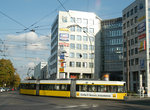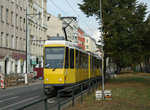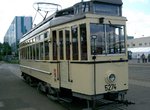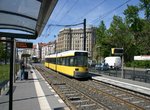Berlin, Germany Trams
![]()
Berlin tram on Rt. 68 at Alt-Schmockwitz loop. Photo by David Pirmann, October 2010.
Overview
Berlin was the first city in the world to introduce electric tramway service (1881), with a pioneering meter-gauge railway in Gross-Lichterfelde designed by Siemens. It became standard gauge in 1925. Ultimately, some 630km of tramways operated in Berlin up to 1929, when the Berliner Verkehrsbetriebe (BVG), which begun operations in 1924, took over all services. The oldest tram line closed in 1934, and general trackage decline ensued during the Third Reich. Following collapse in 1945 along with the demise of the Hitler regime, the status quo remained until 1961, when the Berlin Wall went up. Services in the West Berlin sector ceased operation by 1967, but extensive tram service, still the largest in Germany, continued in East Berlin, and still operates throughout what was once the Communist sector. Some lines in North Berlin have been extended into what was once West Berlin.
BVG operates two types of tram services. The MetroTram routes, with an M prefix, operate 24/7; there are 9 of these, the heaviest one being line M4, which operates from Hackescher Markt past Alexanderplatz into northeast Berlin. Headways are 10 minutes or less on all of these routes during the daytime, with M4 and M5 seeing trams every 2 minutes! Then there are 14 liines, simply called "Straßenbahn", without the "M" prefix, and these run up to 20 hours a day, but can see headways of 20 minutes. Most of these operate in southeast Berlin, but line 12 serves North Berlin as well as other parts of the city. Some routes are now 100% accessible.
There are at least six types of rolling stock. CKD-Tatra T6A2 4-axle PCC-derivative cars in the 5000 series, which run mostly in southeastern Berlin. Then come three types of Tatra KT4Ds, the 4500s, 6000s, 9000s and 7000s, the latter being thyristor-controlled cars. For the most part, the Tatras run as 2-car trains. The newest stock are 100% low-floor AdTranz single-end 1000s (GT6N) and double-end (GT6NZR) 2000s, Weekdays on line M4, both 1000s and 2000s can be coupled in trains. The 2000s are used primarily on line M10, but can be seen on other routes. Many of the low-floors are shrink-wrapped or otherwise decorated with adverts.
Fares are same as on the U-Bahn, with single-ride and day tickets in use.
Other trams in the Berlin region--some very charming interurban routes--operate in Potsdam, Woltersdorf, Strausberg, and Schöneiche.
Photo Gallery
| Five Random Images | ||||
 Image 54672 (216k, 864x574) Photo by: Peter Ehrlich Location: Hohenschönhauser Str./Weißernseer Weg |  Image 54718 (251k, 864x574) Photo by: Peter Ehrlich Location: Hufelandstraße |  Image 54888 (204k, 1044x781) Photo by: Steffen Petrasch |  Image 56057 (178k, 1044x781) Photo by: Steffen Petrasch Location: Betriebshof Lichtenberg |  Image 65499 (216k, 1044x702) Photo by: Steffen Petrasch Location: Mollstrasse/Prenzlauer Allee |
Page Credits
By Peter Ehrlich.